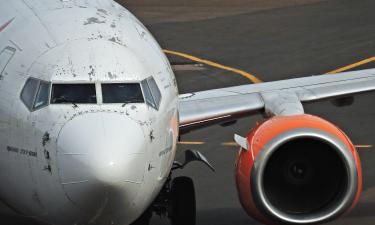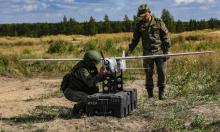A four-winged fossil upends accepted science
SAN FRANCISCO – When scientist Rich-ard Prum looked upon the dinosaur's remains, he could barely believe what lay before him. Locked in a slab of mottled brown stone was the fossil of a creature that, even in the fantastic world of the Cretaceous, seemed to spring more from imagination than from any era of Earth's history. Very clearly, he saw the slender claws of a raptor, the wishbone-like pelvis - and four feathered wings. It was a moment of revelation. For a decade, scientists burrowing through the farmland of northeast China had uncovered flightless, feathered raptors with two wings. The findings had, in no small part, confirmed the widely accepted notion that birds are descendants of dinosaurs.
But this discovery, announced yesterday, was something more. This peculiar creature, it seems, could fly, and etched in the fiber of its feathers and the spread of its wings were clues into one of the most tantalizing mysteries of paleontology: What did the first bird look like, and how did it first take flight?
They are questions that have filled letters and lecture halls since the days of Charles Darwin, when a curious bird-dinosaur was found in the limestone of a Bavarian quarry. Today, the discovery of what is likely that bird's cousin is again forcing scientists to challenge widely held theories.
"It is a remarkable find," says Paul Sereno, a paleontologist at the University of Chicago. "What this team has put together is amazing."
Specifically, Xing Xu and his colleagues at the Chinese Academy of Sciences have put together six specimens of an animal beyond most paleontologists' dreams. And their controversial report in this week's issue of Nature attempts nothing less than the overthrow of core scientific beliefs about avian evolution.
Indeed, they say, the very definition of what a bird is has become murkier. For years, flight with feathered wings had been considered a defining characteristic. Prevailing theories held that birds' ancestors were ground-dwellers, using their wings like chickens to increase speed and balance. What eventually made birds distinct from their dinosaur forebears was the fact that they developed the strength and mechanics to fly.
Yet this new creature, called Microraptor gui, throws that reasoning into doubt. Its asymmetrical feathers strongly suggest an aerodynamic function, and the second set of wings attached to its hind limbs seem inexplicable except as some sort of way to glide from tree to tree.
While some paleontologists remain cautious, many say the evidence is compelling: Dinosaurs, too, could fly, and some forms of flight may have developed from the trees down, not from the ground up.
But that is wheremuch of the unanimity stops, because Dr. Xing goes further. Microraptor gui is not merely a flying dinosaur, he suggests. Rather, it is a relic from the days before birds split off from dinosaurs - showing that birds' ancient ancestors had four wings and first took to the skies as gliders. "Many paleontologists thought it would be almost impossible to find a fossil directly addressing the issue of the origin of avian flight, but now we have a chance to study this question on fossil evidence," says Xing. "The new fossils ... are the link between the flightless dinosaurs and [flying] birds."
No one is laughing at such bold predictions. It's not the first time scientists have looked into a piece of rock and thrown avian history into disarray. When a German miner found what appeared to be a feathered dinosaur in 1860, devotees of Darwin latched onto the creature, later named Archaeopteryx, as proof of evolution.
This was the oldest known bird, they claimed, and they sought its ancestor - the mythical Urvogel or Proavis - as a missing link between dinosaurs and the avian kingdom. By 1915, an American zoologist named William Beebe predicted that this "first bird" was a "Tetrapteryx," an animal with wings on its fore- and hindlimbs. Gradually, Beebe theorized, the hind wings disappeared.
To Dr. Prum, an ornithologist at the University of Kansas, Mr. Beebe now seems something of a prophet.
"After 100 years of questions [into the origins of flight], you start to think that you may not have an answer," says Prum, who writes an accompanying article on the fossil in Nature. "Then you have the animal sitting there in front of you."
Critics, though, are wary of reading too much into the fossil too quickly.
Although they do not doubt the discovery's authenticity, they say more research must be done - and older fossils found - before theories are torn up and rewritten.
They note, for instance, that birds already existed when Microraptor gui was alive roughly 100 million to 150 million years ago. Perhaps it came from a completely different ancestor from the one for birds. Perhaps the creature developed its second set of wings after it diverged from the bird line. And perhaps biomechanical studies will show that the raptor couldn't fly after all.
"It gives us better insight," says Philip Currie, a paleontologist at the Royal Tyrrell Museum in Drumheller, Alberta. "But we're still not sure where this animal fits in."
Mark Sappenfield Christian Science Monitor
The given article is published within the framework of the agreement on cooperation between PRAVDA.Ru and Christian Science Monitor
Subscribe to Pravda.Ru Telegram channel, Facebook, RSS!




